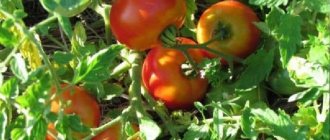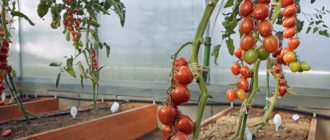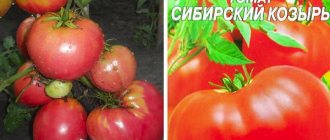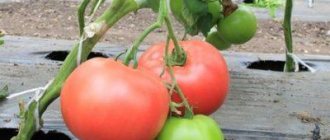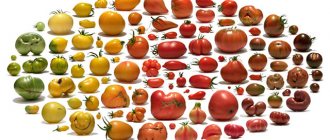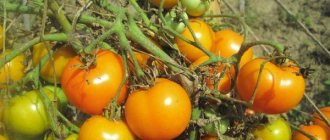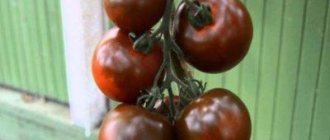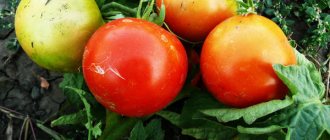Vegetable growers were able to try the Tuz tomato in 2007. It was then that the breeders presented their new variety to the dacha community. Summer residents immediately liked it for its excellent taste.
| Height | Landing location | Ripening time | Fruit color | Fruit size | Origin | Fruit shape |
| short | Open ground | Mid-early | Reds | Average | Variety | Flat-round |
Description
Let's look at the main characteristics:
- The Tuz variety is mid-season. The fruits ripen in 107-110 days.
- Recommended for planting in the Black Earth, North Caucasus, and Central Black Earth regions. Fruits in open ground.
- Bushes of the Tuz variety are determinate. Their height varies between 62-80 cm.
- About 4 kg of fruits are harvested from one bush.
- Tomatoes have a flat-round shape, their surface is slightly ribbed. They are considered medium in size, as their weight can range from 65 to 155 g.
- The fruits are great for making fresh salads. They are meaty and have excellent taste.
- The advantage of the variety is its fairly high resistance to diseases such as fusarium and cladosporiosis.
Having analyzed the reviews about the variety, it can be noted that most of them are positive. The fruits have wonderful taste. Sometimes vegetables grow up to 300 g.
Among the advantages of the variety, it can be noted that it is not a hybrid. This makes it possible to collect the seeds yourself.
Tomato Orange Russian: characteristics and description of the variety, its yield with photos
Every year, breeders never cease to amaze with new tomato crops. So, quite recently, varieties of tomatoes, the so-called bicolor, appeared on the consumer market. These are quite interesting vegetable crops, which, due to their unusual external structure and characteristics of the fruit, are loved by fruit and vegetable growers in many countries. In Russia, the Orange Russian 117 tomato is considered one of the most successful bicolor subspecies. Despite the fact that this hybrid is a foreign selection, it has gained great popularity among Soviet summer residents in a fairly short period of time.
History of the variety and its cultivation
Tomato Orange Russian 117 is a mid-early vegetable crop that was obtained in the USA. The author of the selection achievement is Jeff Dawson. In 2010, the variety was cultivated in Russia, where, after passing all the test work, it was included in the State Register.
As reviews from gardeners have shown, the Orange Russian tomato has proven itself well in the southern and central regions of Russia, as well as in the Non-Black Earth Zone when grown in open ground. In greenhouse conditions, the variety grows well in the Eastern European and Western Siberian parts of the country.
Description of the plant
The variety Orange Russian 117 refers to bicolor plants, that is, when tomatoes consist of two or more colors. The bush itself is also endowed with an unusual structure, which allows it to accommodate a large number of fruits.
Description of the appearance of the plant:
- An indeterminate bush with no growth restrictions.
- On average, the height of the crop reaches 1.8-2 meters.
- The plant is standard-shaped and requires the formation of 2-3 stems.
- The bush is bare, sparsely leafy.
- The leaves are decorative in shape and deep green.
It is also worth noting that the crop has a well-developed root system, which has a beneficial effect on its development.
Productivity and fruit characteristics
The fruits of the Orange Russian 117 variety begin to ripen 111–125 days after the seeds germinate. With the right agricultural technology, you can harvest up to 3 kg from one bush in open holes, and up to 4.5 kg in greenhouses and greenhouses. The fruits of the Orange Russian 117 variety are endowed with many advantages compared to other indeterminate type tomatoes.
Characteristics of the fruit, which can also be attributed to its advantages:
- Weight. The average fruit weight is 300 grams.
- Form. The tomatoes are round, with a pointed tip. Heart shaped.
- Color. The skin of tomatoes is covered with a red tint with orange strokes. The tips of the fruits are deep crimson in color. At the same time, the tomatoes are also of a non-uniform shade from the inside. In the thickness of the orange pulp, red veins are observed.
- Pulp. The inside of Orange Russian tomatoes is dense, with a small number of seeds.
- Taste. The fruits are endowed with good taste, with a predominance of sugar.
- Transportability. Due to their thick skin, tomatoes do not lose their appearance during long-distance transportation.
- Shelf life. For 40 days at a temperature of +2 degrees, the fruits are able to retain their presentation.
According to their intended purpose, tomatoes are used fresh and in preparation: canned whole fruit, sauces, natural juices and tomato pastes.
Tomato variety Russian 117 does not need special care. For its proper development, it will be enough to carry out timely watering, weeding and fertilizing with mineral and nitrogen fertilizers. Also, do not forget about insect pests. Timely prevention will also prevent the formation of infectious diseases.
Seedling
This variety is intended for cultivation not in greenhouses, but in open ground. Breeders bred it for the North Caucasus and Central regions. Here, in early May, seedlings are allowed to be planted in beds. If the weather is warm in spring, this can be done even at the end of April. In this case, the plants should be covered with film after planting to protect them from temperature changes.
Note!
In order for the seedlings to survive the change of location better, they must be hardened off before planting.
When the outside air temperature during the day is at least +17 degrees, the pots can be taken out into the air. First they are exposed for a few hours, and then for the whole day.
During the growing period, you need to feed the seedlings 2 times. 2 weeks after picking and 7 days before planting.
Bush formation
The Tuz tomato bush grows compact and low. The seed manufacturer recommends a 30×50 scheme, which is up to 8–9 bushes per 1 m2. Such thickening is possible only with extensive experience in forming and staking plants. It is better not to exceed 5 bushes per 1 m2 and try to grow a tomato with 2–3 stems. Although the variety is determinate and usually does not exceed 80 cm, due to the large weight of the fruit it requires gartering to a support.
To save yourself from constantly loosening the beds, it is convenient to mulch the plantings with sawdust or peat.
Advice. After the ovary has formed, the lower leaves are thinned out. This will allow air to circulate better between the plants and allow sunlight to reach the fruits.
Features of formation
The bushes grow small, quite compact and not very tall. It is recommended to plant them according to the 30x50 pattern. There are about 8 bushes per square meter. But planting seedlings so densely is recommended only for those gardeners who have sufficient experience in staking bushes and shaping them. If you have little experience, it is better to plant 5 plants per unit of area. Bushes are grown with 2-3 main stems. The plants are not tall, but the weight of the fruits is quite large. Because of this, the bushes need to be tied up.
Description of fruits
The Tuz tomato has a bountiful harvest. In addition, there are other positive aspects. The taste of tomatoes is similar to salad fruits. They are meaty and sweet. However, unlike most varieties of salad tomatoes, these are universal. They are suitable for everything, including whole canning.
It is worth noting that the fruits of the Tuz variety grow in different sizes. Most of the harvest will consist of small pink tomatoes weighing about 150 g. There are smaller specimens.
They are well suited for whole marinating and pickling. But quite large tomatoes will form on the lower branches. Their weight can reach 350 g. These tomatoes can be left for salads or juices.
Video: Tuz tomatoes
For the first time, vegetable growers tried the Tuz tomato from the breeding plant in 2007. Many people liked the variety for its excellent salad qualities. The general description from the manufacturer can be summarized as follows:
- mid-early variety (106–110 days);
- suitable for open ground (North Caucasus and Central Black Earth regions);
- determinate bush (60–80 cm);
- yield 3.5–4.5 kg per bush;
- tomato is slightly ribbed, flat-round, medium size (65–152 g);
- the fruits are tasty, fleshy, salad-like;
- resistant to diseases (cladosporiosis, fusarium).
In general, reviews of the Ace tomato are positive. The tomatoes grow delicious and are suitable for summer salads and marinades. Some specimens weigh up to 300 g, but on average the fruits are small, about 100–150 g.
Characteristics of tomato
Ace is a ground plant and is optimally suited for the southern regions of the country. In the central part of Russia, you can grow tomatoes in a greenhouse. However, the greatest harvest can be obtained in open beds. Moreover, this will protect plants from many diseases. In general, Ace is considered not a particularly demanding tomato. He does not suffer from cladosporiosis and fusarium. But other ailments, including fungal ones, can affect bushes. Therefore, high humidity for this variety will be contraindicated.
Tomato Ace is considered medium early. The first harvest can be harvested already 100 days after sowing the seeds. Fruit ripening is not particularly fast, so you can pick ripe tomatoes over a long period of time.
This variety is considered determinate; the plant does not grow more than 80 cm. If the summer is hot and the weather is often windy, it is possible that the bushes will be no more than 60 cm in height. This suggests that such plants do not require garter. There is no special formation for compact bushes, which makes the plant largely suitable for beginners in gardening.
Read also: What mushrooms are currently available in Belarus?
Experts recommend planting the plant in a permanent place from seedlings. It must be hardened to withstand the vagaries of weather that are possible when growing tomatoes in open ground.
For the Tuz variety, you should choose good and fertilized soil. The best predecessors for these tomatoes are zucchini, cabbage, cucumbers, legumes, parsley and dill. It should be taken into account that in determinate varieties, bushes in pots with seedlings may not be particularly tall. But they must be strong, since only in this case can you get a high-quality harvest of tasty and healthy tomatoes.
Productivity is affected not only by the quality of the soil and the amount of fertilizing. It is also necessary to loosen the soil and weed it from weeds. In addition, it is necessary to plant the bushes in the correct pattern. For the Tuz variety, which is considered quite compact, a higher density is acceptable. Up to 6 plants can be placed per 1 m². This will increase the yield, which will reach a maximum of 5 kg per bush. With the right agricultural technology, you can harvest from 1 square to 13 kg of delicious tomatoes.
Seedling
Seedlings are sown in late March or early April. The soil is collected nutritious, rich in humus. The garden soil from the future garden bed is enriched with humus, compost, and peat.
Advice. Boxes for seedlings should have large drainage holes to prevent water stagnation.
After 2 weeks, the seedlings are transplanted into separate pots with a volume of 0.8–1.5 liters; there is no point in taking more containers. The variety is of a determinate type, the bushes have time to grow small, and planting in the ground is possible already at the age of 40–50 days.
The Tuz tomato variety was bred by breeders for cultivation mainly in open ground in the Central and North Caucasus regions. Planting in beds in these places is usually possible as early as early May, and in warm years, at the end of April. But for the first time, it is advisable to cover the planting of tomatoes with a transparent film.
Important! Before moving to a permanent place, seedlings must be hardened off.
As soon as the daytime temperature outside begins to rise above 17–18 ⁰C, the pots are exposed to fresh air, gradually increasing the time from 1 hour to a full day.
Vegetable growers were able to try the Tuz tomato in 2007. It was then that the breeders presented their new variety to the dacha community. Summer residents immediately liked it for its excellent taste.
| Height | Landing location | Ripening time | Fruit color | Fruit size | Origin | Fruit shape |
| short | Open ground | Mid-early | Reds | Average | Variety | Flat-round |
Tomatoes and their varieties
Red, yellow, purple, black, green, orange, striped and even two-colored... They come in different colors, and choosing the best variety of tomatoes for yourself can be difficult. Firstly, the variety of varieties is amazing.
Secondly, the choice must be made based on the conditions in which the plants will grow: greenhouse, open ground, shade or sunny area.
Thirdly, both determinate and indeterminate varieties need to be planted on the site to ensure maximum yield.
Determinate and indeterminate tomatoes and their characteristics
Summer residents and owners of personal plots rarely use these words. Determinate plants have a limited growth point, which means they do not grow tall. But indeterminate tomatoes are taller and require more attention in care. They need to be tied up, pinched and provided with the proper conditions for growth.
If tall tomatoes grow better in greenhouse conditions, then low-growing ones can be planted in open ground and used for greenhouses. The list of low-growing varieties is large, so you can choose different types of tomatoes.
Indeterminate varieties of tomatoes during one season (if grown in heated greenhouses, they produce about 40-50 bunches). If the plants are in ordinary greenhouses in the country, then the number of tassels rarely exceeds 30 tassels.
In the southern regions, tall varieties can be planted in open ground. If your summer is cold and short, then it would be better to minimize the planting of tall varieties.
They harvest later and in the northern regions do not always have time to ripen.
Determinate tomatoes have lower yields, but they ripen faster. Most varieties require tying and shaping. If you do not have time for care, then preference should be given to standard varieties. This is one of the varieties of determinate tomatoes with a short, strong stem. They don't need any tying or shaping.
Amazing tomato tree
Every year about 2,000 people come to the tomato tree. This is a tomato variety Sprut F1. The advertisement says that the plant produces about 14,000 tomatoes per year. One of these trees grows in China.
It requires constant care and temperature and intensive fertilizing, has reached a height of 4 meters and has been growing for several years.
But in dacha conditions, almost no one managed to achieve such results
Cherry tomatoes: a little hit in the gardens of summer residents
When it’s time to clean out greenhouses or greenhouses, clear the beds of plants, many gardeners wonder: where to put the Cherry tomato bushes? The fact is that a significant part of the varieties are suitable for growing in pots, and after transplanting they can bear fruit until the New Year.
The cherry-shaped hybrids Cherry Lykopa, Lisa, Kira, Ira, Maksik and some others are ideal for growing. The peculiarity of the fruits is that they are perfectly preserved and can last for more than a month. And at the same time they will not deteriorate and will not even begin to rot! And the Cherry Kira hybrid can be stored for about 2.5 months. For this reason, sellers and summer residents like it so much.
Cherry Lisa tomatoes can be safely planted in a pot and grown on a windowsill.
Cherry tomatoes should be collected and stored using trusses. This will preserve the taste and aromas of the fruit. By the way, Cherry can also be used as an ornamental plant.
You can plant them in ordinary buckets - the volume will be enough to grow a full-fledged bush.
Description and characteristics of the variety
The ace was included in the state catalog in 2007. Originator - agro, Moscow. The variety is recommended for the Central Black Earth and North Caucasus regions. Designed for the street and can be grown in private farms.
Salad cultivar, mid-early ripening. The fruits are harvested 100-103 days after germination. Tomatoes are flat-round, with small ribs. When unripe they are light green, when ripe they are bright red. Average weight 100 g, maximum 152 g, minimum 65 g. The fruit is multilocular, contains 4-6 seed chambers. The taste is excellent.
Reviews
I have been growing Tuz tomatoes from Gavrish for several seasons in a row. I planted only a few of these tomatoes, 4-5 bushes each, but this was enough for delicious salads all season. The whole family likes tomatoes, they are juicy and meaty. I collected my own seeds for next year and will definitely plant them.
source
Vegetable growers were able to try the Tuz tomato in 2007. It was then that the breeders presented their new variety to the dacha community. Summer residents immediately liked it for its excellent taste.
| Height | Landing location | Ripening time | Fruit color | Fruit size | Origin | Fruit shape |
| short | Open ground | Mid-early | Reds | Average | Variety | Flat-round |
Reviews
I have been growing Tuz tomatoes from Gavrish for several seasons in a row. I planted only a few of these tomatoes, 4-5 bushes each, but this was enough for delicious salads all season. The whole family likes tomatoes, they are juicy and meaty. I collected my own seeds for next year and will definitely plant them.
I planted Tomatoes Ace last season. I grew one bed as a test. The bushes turned out to be small, but quite a lot of tomatoes were ripe for a salad variety. I liked the taste, good sweet and sour tomatoes. I love these and will continue to plant them.
source
